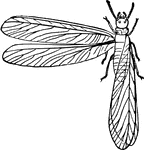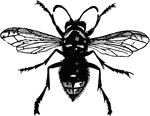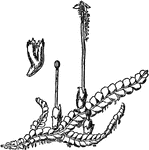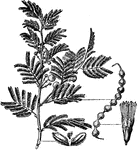
Jasmine
"Botanically Jasminum, a genus of shrubs or climbers constituting the principal part of the natural…
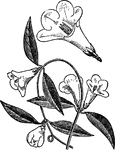
Gelsemium
"The plant known in America as the "Carolina jasmine" is not a true jasmine. other hardy species commonly…
Increased Velocity
"The principle of increased velocity as bodies descend from a height, is curiously illustrated by pouring…

Safflower
A high branched flower whoes petal consist of longspiny leaves. Usually bright yellow, orange or red.

Camera Obscura
"Camera obscura strictly signifies a darkened chamber, because the room must be darkened, in order to…
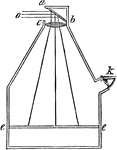
Camera Obscura
"Camera obscura strictly signifies a darkened chamber, because the room must be darkened, in order to…

Solar Spectrum
"Solar Spectrum.—If a ray, proceeding from the sun, be admitted into a darkened chamber, through…
Sun Eclipse
"When the moon psses between the Earth and Sun, there happens an eclipse of the Sun, because then the…
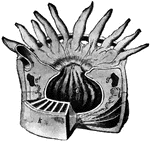
Anemone
"Sea anemone dissected; c, tentacles; d, mouth; e, stomach; white lines above k, the mesenteries." —Davison,…
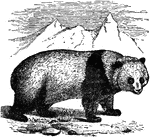
Giant Panda
Ailuropus Melanoleucus. "A. melanoleucus, discovered by Pere David in 1869, in the most inaccessible…
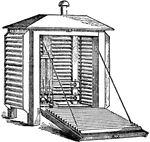
Thermometer Box
"Stevenson's louvre-boarded box for the thermometers, which is now very widely used for temperature…
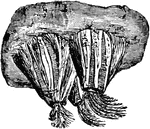
Barnacles
A white or brown arthropoda. Has a pair of cirri, which form a net used to scoop food particles out…
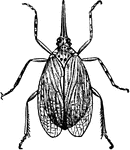
Lantern Fly
Lantern-flies may be found on the under side of leaves of various plants, particularly grape, sucking…

Lantern Fly
Lantern-flies may be found on the under side of leaves of various plants, particularly grape, sucking…
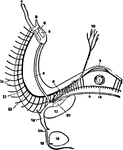
Brachiopoda
Diagram of nervous system of Crania; from the dorsal side. The nerves running to the dorsal parts are…

Checkered White Butterfly
Pieris Protodice, a butterfly that becomes more common and assists its imported relative in making havoc…

Checkered White Butterfly (Female)
Pieris Protodice, a butterfly that becomes more common and assists its imported relative in making havoc…

Checkered White Butterfly Larva and Chrysalis
Pieris Protodice, a butterfly that becomes more common and assists its imported relative in making havoc…
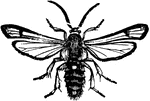
Blackberry Borer Male
A black, very little marked with yellow, and the only satisfactory remedy is cutting out and destroying…
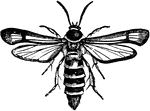
Blackberry Borer Female
A black, very little marked with yellow, and the only satisfactory remedy is cutting out and destroying…
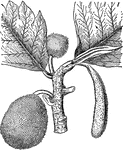
Bread-Fruit Tree
A bread-fruit tree with cuneate-ovate pinnatifid leaves, male flowers in a club-shaped deciduous catkin,…

Velvet Ant
Also known as cow killers, are not actually ants but a type of wasp. they get their name from their…
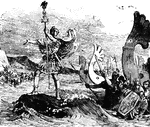
Julius Caesar
Julius Caesar heard that a little way off there was a country nobody knew anything about, except that…

Bryophyta
Sphagnum acutifolium. Longitudinal section of apex of a bud bearing archegonia (ar), enclosed by the…
Bryophyta
Sphagnum acutifolium. Ripe sporogonium raised on the pseudopodium above the enclosing leaves

Butterwort
Glands from surface of leaf by which the sticky liquid is secreted and by means of which the products…

Towers of London
The White Tower, the square building with turrets on each corner that gave it its name, is actually…

Early Flax Seedling
Growth of Flax seedling from a stem with two leaves and a bud, to a stem with several leaves and stem…

Common Bean Seedling
Caulicle well lengthened and root beginning; thick cotyledons partly spreading; plumule (pair of leaves)…
Beech-nut Germination Older
Older beech with the plumule-leaves developing, and elevated on a long internodes.
Pea Germination
Pea germination: the plumule has developed four or five internodes, bearing single leaves; but the first…

Acanthus
A genus of plants or shrubs, mostly tropical, two species of which arecharacterized by large white flowers…
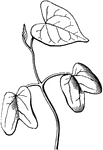
Morning Glory Seedling
Seedling of Morning Glory more advanced (root cut away); cotyledons well developed into foliage-leaves:…
Iris Germinating
A germinating seedling of the Iris, its plumule developed into the first four leaves (alternate), the…
Shoot of Horse-chestnut
Shoot of Horse-chestnut, of one year's growth, taken in autumn after the leaves have fallen; showing…

Auxiliary Bud
An auxiliary bud, concealed under the hollowed base of the leafstalk, in Buttonwood or Plane-tree.





